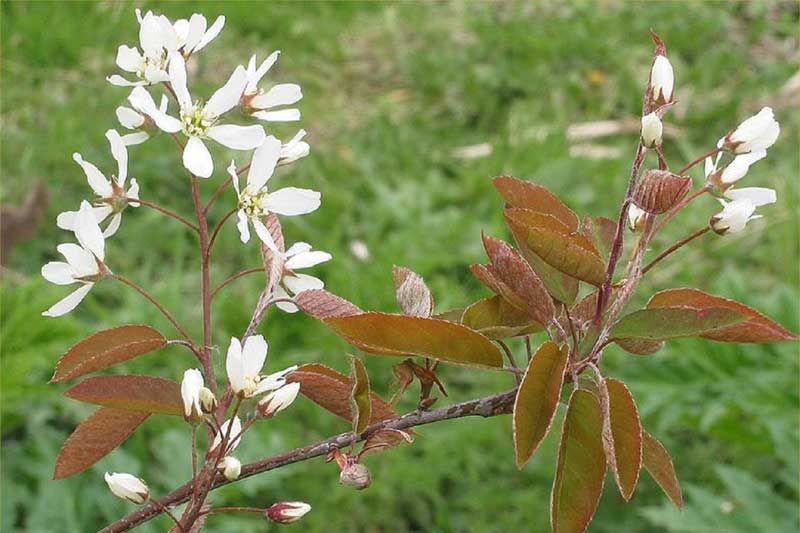Steve Blight | Apr 10, 2013
by Steve Blight
As the first blush of green spreads across the land, among the earliest flowers seen on the landscape belong to serviceberry shrubs and trees. Found on rocky ridges, forest edges and hedgerows throughout our area, the serviceberries’ abundant two-centimeter flowers add a splash of white to the patina of emerging green in the background. The five-petaled flowers themselves are white, but the new leaves that begin to emerge at the same time have a reddish-green tone that gives an overall pinkish-white look to the flowering tree when seen from a distance.
Serviceberries have several other common names – juneberry, shadbush, shadblow and Indian pear, amongst others. Generally serviceberries are either small trees or shrubs. I don’t think I have ever seen one with a trunk diameter much larger than about 10 centimetres, but no doubt they are out there! There are about 10 different serviceberry species found as native plants across Canada. Some authors distinguish as many as six species in our area, but I have a confession to make – alas, I have a great deal of difficulty distinguishing one species of serviceberry from another. Apparently serviceberries hybridize frequently, so specimens exhibiting characteristics of more than one species are common. But rest assured that while distinguishing between species of serviceberries is hard, identifying a specimen as a serviceberry is straightforward.
In western Canada there is a very common species of serviceberry known as the saskatoon. They are found along streams and in sheltered ravines called coulees across the prairies. Like all serviceberries, saskatoons produce a 6-10 mm in diameter purplish-red, berry-like fruit. These fruits are technically known as “pomes” – apples, pears and mountain ash berries are all examples of pomes. Saskatoons are widely harvested, making excellent preserves, pies and sauces. I have two stories about saskatoon pies I’d like to share from my time in western Canada. The first is the very best saskatoon pie I have ever eaten. Many years ago there was a small family-run restaurant in Waterton, the small town nestled in the middle of Waterton Lakes National Park in southern Alberta. This restaurant was known far and wide for its saskatoon pies – big slices, bursting with sweet, juicy saskatoons safely tucked in a flakey golden crust. Our frequent trips to Waterton were always capped off with a slice of this wonderful desert.
By contrast, I once found myself hungry and looking for dinner in a mostly forgotten corner of Saskatchewan about half way between Regina and Saskatoon (the city, not the berry…). I stumbled across a diner that had clearly seen better days. The sandwich board sign set up on the sidewalk outside promised good home cooking, so in I went. After a highly forgettable main course, I felt confident that at least the saskatoon pie on the menu would be good – after all, we were right in the middle of prime saskatoon habitat (the berry, not the city…). So the order was placed, and the pie arrived. It was not a good choice. The crust was white, tough and soggy, and when I peeled back the top crust, the filling consisted of four forlorn saskatoon berries sitting in a bed of whitish goo. I picked disappointedly at the four berries, paid and left. Thus defines the two ends of the spectrum of my personal experience with saskatoon pie.
Birds and other animals like serviceberries as well. A serviceberry in full fruit in June or early July is bound to attract American Robins and Cedar Waxwings, and maybe the odd squirrel as well. Serviceberries are easy to find at nurseries and generally grow well in our area as long as they receive at least a couple of hours of direct sunshine a day. They add colour and four-season interest to town or country landscapes, with their pleasing form and structure adding appeal to winter gardens. Plant a few serviceberries and perhaps there will be enough fruit to create your own pie experience – if the birds don’t get them all first!
Please feel free to report any observations to Lorraine Julien at This email address is being protected from spambots. You need JavaScript enabled to view it. or Steve Blight at This email address is being protected from spambots. You need JavaScript enabled to view it.
More Stories
- Latest CUPW Job Action Stops Postal Delivery Of The Frontenac News Forcing Alternate Plans
- Opponents of Barbers Lake Gravel Pit Pack Ag Hall in McDonalds Corners
- Bobsleigh Olympian Jay Dearborn At Mikes Pizza In Sydenham
- The Loins Club Of and O'Lakes Roar
- North Frontenac Back Roads Studio Tour - September 27 and 28
- Sunday Market Vendors Give Back
- George Street Work As Town Hall Renovation Nears Completion
- One Way Street Plan Hits A Dead End - Central Frontenac Council, September 9
- Global Gardening
- No Winner Yet in Catch The Ace But Fundraising Target Met

